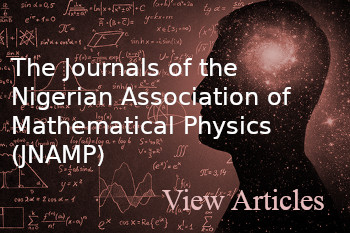REMOVAL OF METHYL ORANGE DYE FROM AQUEOUS SOLUTION USING GROUNDNUT (Arachis hypogaea) SHELL AS ADSORBENT
Keywords:
Groundnut shell, Methylorange dye, ThermodynamicsAbstract
This work was conducted to determine the ability and effectiveness of groundnut shell to remove methyl orange dye from aqueous solution. The biomass (groundnut shell) was characterized for some physico-chemical properties, before it was used for adsorption studies. The results obtained indicated that the biomass has a positive surface charge with pH of 6.80 at point of zero charge. The results from fourier transform infra- red spectroscopy (FTIR) revealed that the biomass (GS) contain O- H, C-H, C-O, CH2, C-O-C and C=O functional groups. The results from proximate analysis of the biomass showed that the groundnut shell has high content of fibre
(cellulose, hemicellulose and lignin) as well as low moisture content. The GSA, was further used for the removal of methyl orange dye from aqueous under the influence of some adsorption variables. Data obtained revealed that increase in the Initial dye concentrations, increased the methyl orange removal efficiency. The optimum percentage color removal efficiency was obtained as 72% at 100gldm 3 of the initial dye concentration. However increase in PH increased color (methyl orange) removal efficiency. At pH 2-6, 3.653-6.738 mg/g of methyl orange was removed. The process was favoured by increase in adsorbent dosage evident to the (45.3 - 69.5%) of color
removal efficiency when the adsorbent was varied (0.2g – 11.0g). Similarly, variations in temperature enhanced color removal. Optimum temperature for color removal was obtained at 50OC with 69.6% color removal efficiency. Contact time (20 – 100) mins variations revealed 46.1 – 64.8% color removal efficiency. The experimental data were further subjected to some adsorption kinetics and isotherms to understand the mechanism of the process. The process was found to follow the Pseudo-second order kinetic model with a correlation coefficient of 0.9887 and K 2 of 0.0358 g/mg-1. Also the Langmuir adsorption isotherm was better suited to describe
the adsorption mechanism with a correlation coefficient of 0.9763, K L of 0.051 and qmof 2.96 mg/g. The free energy change ΔG from the thermodynamic studies revealed that the process is feasible and spontaneous, negative value of enthalpy change (ΔH) indicates an exothermic adsorption process and the positive and large value of entropy change (ΔS) reflects a high rate of disorderliness. The groundnut shell is a good adsorbent for the removal of methyl orange dye from aqueous solution.
Downloads
References
Chakraborty, P., Ramteke, D., Chakraborty S. and Nath B. N. (2014). Changes in metal contamination levels in estuarine sediments around India – An assessment. Marine Pollution Bulletin, 78: 15-25.
Ikpeaiyeda, A. R. and Tesi, G. O. (2014). Sorption and Desorption Studies on Toxic Metals From Brewery Effluent Using Eggshell as Adsorbent. Advances in Natural Science, 7(2): 15-24.
Ekpekpo and Asiagwu Trans. Of NAMP Renjith, K.R., Sudheesh, V., Shaji, A., George, E., Joseph, M.M., Ratheesh Kumar, C.S. and Chandramohana Kumar, N. (2015). Geochemical distribution, bioavailability and potential toxicity of some trace metals in a complex micro-tidal estuary, Southwest India.Toxicological and Environmental Chemistry, 98(1): 36-52.
Ibrahim, M.B., Ibrahim, A.M., HAruna, M.A. and Yaro, M.S. (2013). Removal of congo red dye from aqueous solution using sugarcane baggase and Bambara groundnut shell. Chemsearch Journal, 4(1): 22-28
Asiagwu, A.K., Emoyan, O.O. and Ojebah, C.K. (2018). Removal of tartrazine yellow dye from aqueous Solution using groundnut shell as biomass: Kinetic approach. International Journal of Engineering Research and Technology, 7(5): 404-411
Alene, A.N., Abate, G.Y., Habte, A.T., (2020). Bioadsorption of Basic Blue Dye from Aqueous Solution onto Raw and Modified Waste Ash as Economical Alternative Bioadsorbent. Journal of Chemistry 11. https://doi.org/10.1155/2020/8746035.
Metivier-Pignon, C., Faur, P. and Coirec, L. (2007). Adsorption of dyes onto activated carbon cloth using QSPRS as tools to approach adsorption mechanism. Chemosphere, 66: 887- 889
Crini, G., Lichtfouse, E., Wilson, L.D., Morin-Crini, N., (2019). Conventional and non-conventional adsorbents for wastewater treatment. Environmental Chemistry Letters 17, 195–213. https://doi.org/10.1007/s10311-018- 0786-8
Imam, S.S. and Abdullahi, M. (2017). Adsorptive removal of methylene blue using groundnut shell activated carbon coated with Fe2O3. IOSR Journal of Applied Chemistry, 10(4): 12-21
Das, N., Karthika, P., Vimala, R. and Vinodhini, V. (2008). Use of natural products as biosorbent of heavy metals—An overview. Natural Product Radiance, 7(2): 133 – 138.
Kumar, S., Gunasekar, V. and Ponnusami, V. (2013). Removal of methylene blue from aqueous effluent using fixed bed of groundnut shell powder. Journal of Chemistry, Article ID 259819 https://dx.doi.org/10.1155/2013/259819
Jeyaseelan, C. and Chauchan, K. (2015). Removal of congo red from aqueous solution using groundnut shells. Journal of Basic and Applied Engineering Research, 2(11): 910-914
Kamaraj, M. and Umamaheswari, P. (2017). Preparation and characterization of groundnut shell activated carbon as an efficient adsorbent for the removal of methylene blue dye from aqueous solution with microbiostatic activity. Journal of Materials and Environmental Sciences, 8(6): 2019-2025
Kayranh, B., Gok, O., Gok, G. and Masutoglu, O.C. (2019). Textile dye removal from aqueous solution by using peanut and pistachio shells. International Journal of Environmental Pollution and Environmental Modelling, 2(5): 270-276
Ezenwa, O.S and Ogochukwu, N.H. (2021). Comparative analysis and regenerative studies of alkaline modified groundnut shell as adsorbent for the removal of oil layer from polluted water. Journal of engineering, research and report, 20(2): 76 – 86.
Boumehita, S., Lahrich, A., Benjelloun, Y., Lairini, S. Nevou, V and Zerouq, F. (2017). Application of peanut as a low-cost adsorbent for the removal of anionic dye from aqueous solutions. Journal of materials and environmental sciences 8(7): 2353 – 2364.
AOAC, (2000). Official methods of analysis of Associaation of official chemists international, 17 th Ed. Al-Ghouti, M.A. and Al-Absi, R.S. (2020). Mechanistic of the adsorption and thermodynamics aspect of cationic methylene blue dye on cellulosic olive stones biomass from wastewater. Scientific Report, 10, 15928. https://doi.org/10.1038/s41598-020-7299-3.
Ayawei, N., Ebelegi, A.N., Wankasi, D., (2017). Modelling and Interpretation of Adsorption Isotherms. Journal of Chemistry 2017, 1–11. https://doi.org/10.1155/2017/3039817
Ademoriyo, C.O., and Enyoh, C.E. (2020). Batch adsorption study of sunset yellow and tartrazine using coconut and groundnut shells. Journal of biomedical research and environmental sciences. 6(9): 163 – 172. http://doi.org/10.37871/jbres1137.
Bayou, J., Pelig-Ba, K.B and Abukari, M.A. (2019). Adsorptive removal of chromium from aqueous solution onto groundnut shell. Applied water science, 9(107): 2-11. https://doi.org/10.1007/s13201-019-09-8
Wu, J., Xia, A., Chen, C., Feng, L., Su, X., and Wang, X. (2020). adsorption thermodynamic and dynamics of three typical dyes onto bioadsorbent , spent substrate of pleurotus eryngii. International journal of environment, research, and public health. 16(5): 679. https//doi.org/10.3390/IJERPH/6050679.
Ajala, L.O and Ali, F.E. (2020). Preparation and characterization of groundnut shell-based activated charcoal. Journal of applied science and
environmental management, 24(12):2139 – 2146. https://dx.doi.org/10.4314/jasem.v24i12.20





